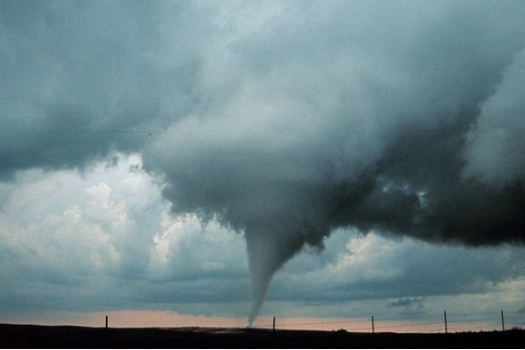

Scientists generally agree that climate change will increase the likelihood of extreme weather events, but the jury is still out on how tornadoes will fare in a warming world. Tornadoes are fickle beasts, and it remains tough to predict a tornado a week from now, much less what they might be like over the next few years.
“The most common finding is a warming environment leads to more storms and more intense storms, but intensity doesn’t necessarily mean organizing and producing tornadoes,” says Grady Dixon, an associate professor of geosciences at Mississippi State University who studies tornado climatology. “It takes a certain interaction.”
Jeff Trapp, a professor of atmospheric science at Purdue University, says that while it’s unclear how the intensity or frequency of tornadoes will increase, there may be more days featuring conditions ripe for twisters. “We would see an increase in the number of days that could be favorable for severe thunderstorm and tornado formation,” he says. The tornado season, which varies by region, could be expanded.
In yet another theory, Harold Brooks of the National Weather Center recently told the AP that there could be a sort of condensing effect–more tornadoes occurring on fewer days of the year.
Tornado patterns have been especially wonky as of late: 2011 marked the second-deadliest tornado season for the U.S., with 1,700 tornadoes (including the particularly destructive Joplin one) and 553 deaths, according to the AP. And then, after an early start to the tornado season in 2012, the numbers reversed. The period between May 2012 and April 2013 featured the fewest tornadoes on record and the second-lowest death toll, according to the National Oceanic and Atmospheric Administration’s U.S. Severe Weather Blog.
Where we’re going as a community is to try to have climate models that are finer resolution.It’s also difficult to discern whether we’re seeing more tornadoes in recent years, or if awareness of them has just gone up. Since the 1990s, Dixon says, there’s been an increase in tornadoes in the Midwest and northern Great Plains region and a decrease in the southern Great Plains, but that could be merely a result of better reporting.
Oklahoma is a magnet for tornadoes because it’s right at the convergence point where humid air from the Gulf of Mexico collides with cooler air from the high terrain of Mexico and the Rocky Mountains. Tornadoes require strong upper level winds, up to three miles above the ground, to contrast with slower currents near ground level in what’s called wind shear. It often occurs when warm temperatures from the south run into colder temperatures from the north.
A warming climate creates warmer temperatures in the north, so in that respect, decreasing wind shear, so it could actually lead to fewer tornadoes, according to Dixon.
However, another factor suggests that climate change will do the exact opposite. Convective available potential energy, or CAPE–essentially the amount of energy that’s available to for storms–is determined by moisture and temperature differences between the ground and higher regions of the atmosphere. “The CAPE increases with time in a globally warmed world, mainly because the temperature near the ground and lower parts of the atmosphere increases and becomes more humid,” Trapp says. “In a globally warmed future world, that thunderstorm should be more intense.”
Because of these conflicting factors, “what we don’t know is how this necessarily affects tornado intensity and frequency,” Trapp says.
His research deals with climate change models, which are still very coarse when it comes to tornado prediction–a single pixel can be up to 100 km on a side, while individually storms are typically only half that size. “Where we’re going as a community is to try to have climate models that are finer and finer resolution, like how digital cameras have higher and higher resolution,” he says. With higher resolution models, researchers hope to be able to analyze storm simulations that would allow them to determine which types of storms form tornadoes with more certainty.
